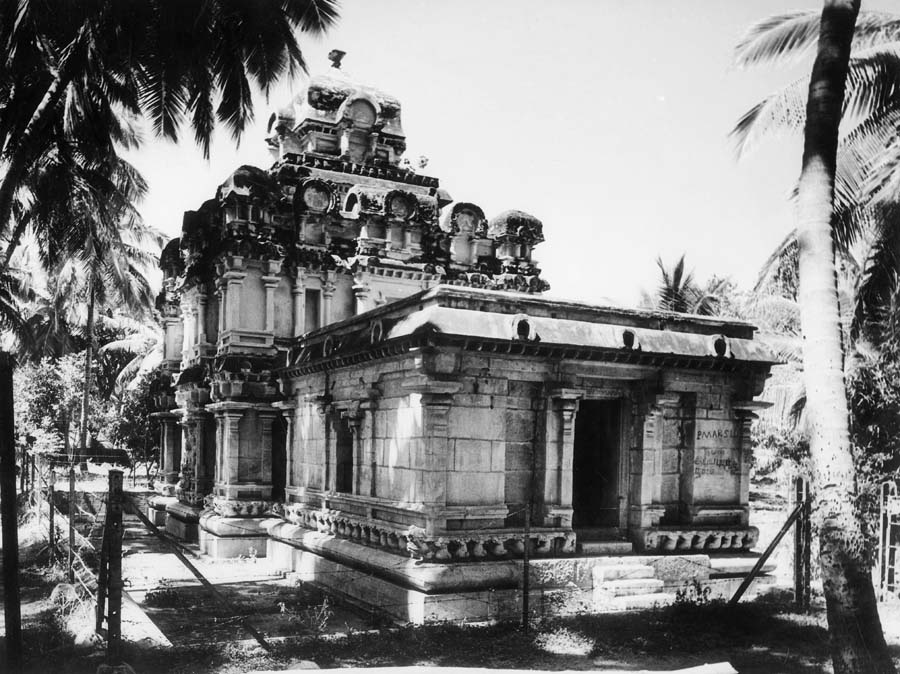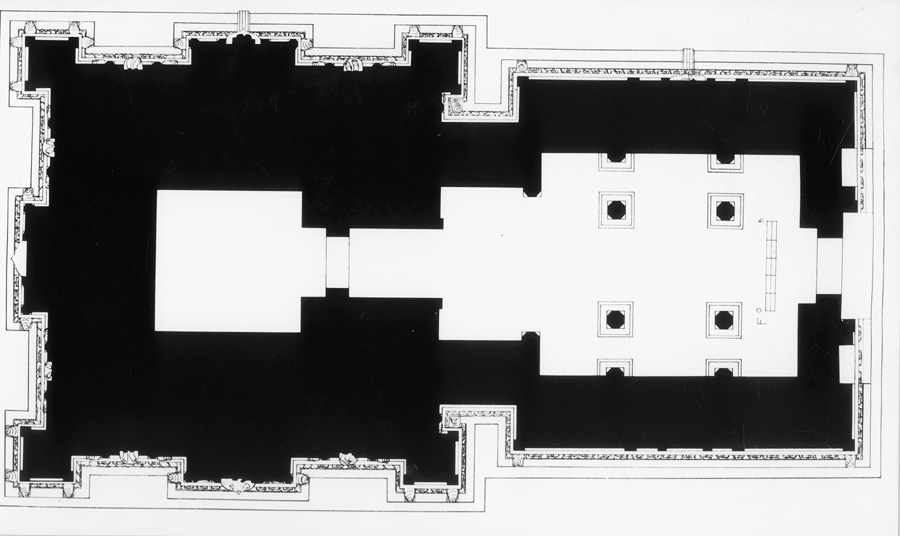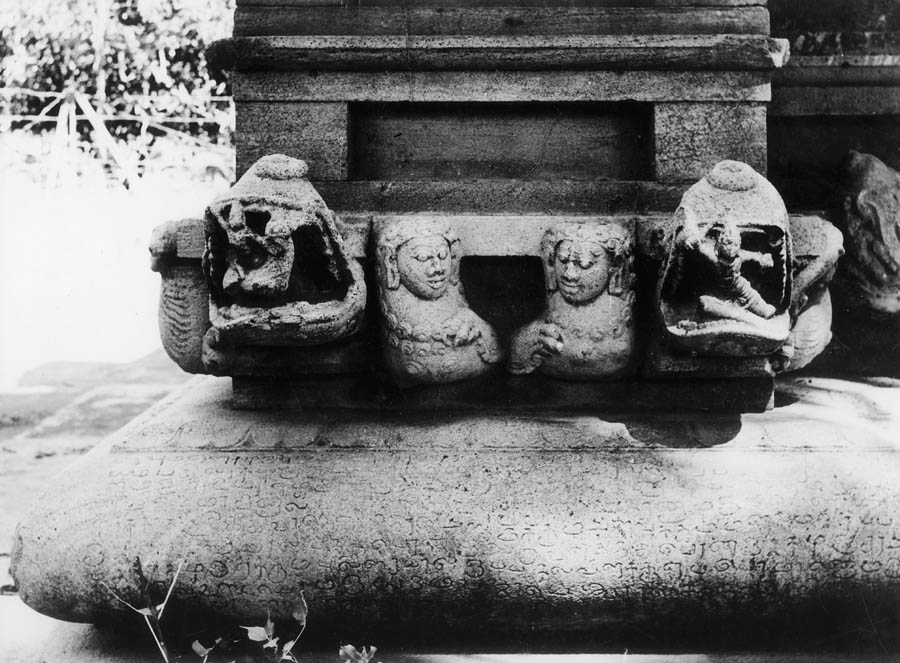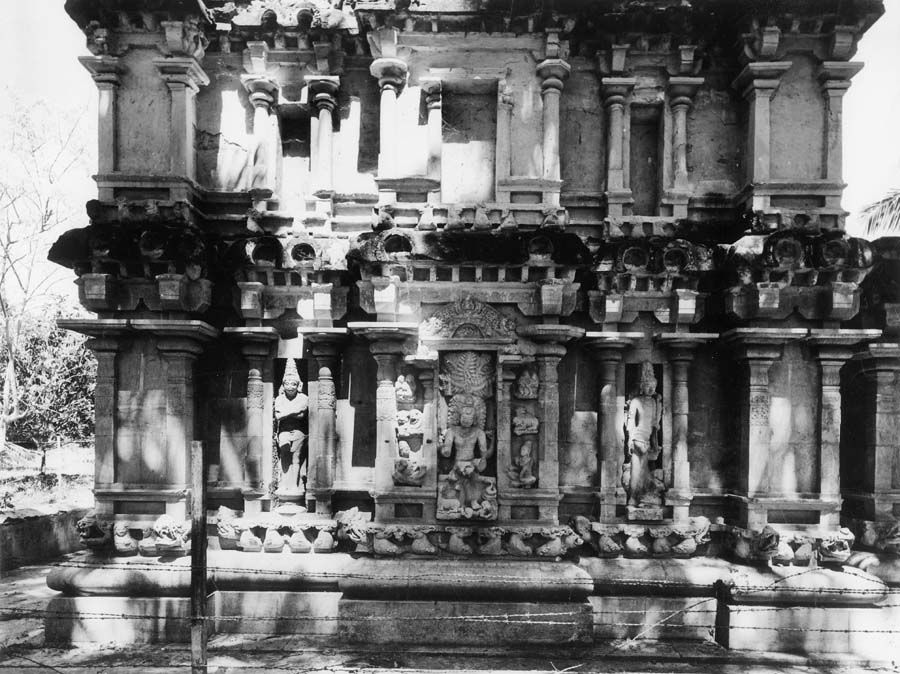Srinivasanallur is a village situated in Tiruchirappalli district of Tamil Nadu. It is located about 50 km from the district headquarters. The region is referred as Mahendra-mangalam in its inscriptions suggesting that it was once part of the Pallava territory sometime during the reign of the Pallava king Mahendravarman I (600-630 CE).
Monuments – There are many temples of interest at the village however, this article is focused only on the Koranganatha temple which is under protection of the Archaeological Survey of India.

Koranganatha Temple – This small but majestic temple is considered as one of the finest specimen of the early Chola period art. However, as there is no foundation inscription found, the construction and its royal association to the Cholas cannot be determined with certainty. The earliest inscriptions on the temple refer to the early Chola kings, therefore it may be surmised that it was constructed during the final decades of the ninth century CE. There are two legends associated with the temple. First mentions that the temple was built by a sanyasi and at the time of consecration, a monkey was found at the top of the temple. Seeing a monkey was taken as a bad omen and the temple was left deserted1. Another legend states that first it was a temple for Hanuman worshipped by Madhavas, then Hanuman was replaced with Ganesha by religious opponents and finally Madhavas turned out Ganesha2. The temple is referred as Tirukkurakkutturai-Perumanadigal in its inscriptions.


The temple faces east and is built as a dvitala (double storey) vimana structure. It consists of a garbha-grha (sanctum) followed by an antarala and an ardha-mandapa. The antarala made this temple unique as this feature is absent in contemporary temples usually attributed to the early Chola period3; Panangudi, Visalur, Kaliyapatti, Kodumbalur, Tirukattalai etc. Adhishthana is of vaprabandha type, composed of upana, jagati, vrtta-kumuda sandwiched within two lotus cusps (adhah- and udrhva-padma), kantha as prati-mukha with vyala-vari and sandwiched within two kampa courses and pattika or prati-vajana. Above the adhisthana rises a vedi or wall-kantha. Vyalas over the kantha are taken amongst the best such specimens produced during this period. At the corners are placed makaras with open mouth and a rider or animals inside. This vaprabandha adhishthana and its decoration scheme is taken as an original Chola style by Barrett4.

Bhitti (wall) rises above adhisthana and is fashioned in pancha-ratha mode consisting of a central bhadra niche, corner karna and intermediate prati-karna niches. The style may also be termed as tri-ratha as the two intermediate niches are provided in the recess sections between bhadra and karna, for this article we will take it as pancha-ratha having five niches. Usage of different forms of pilasters over the bhitti is of special interest. Bhadra and prati-karna niches have rudra-kantha (round section) pilasters while karna niche has brahma-kantha (square section) pilaster. Bhadra-niche is given special attention, provided with a makara–torana above its rudra-kantha pilasters and the whole niche is encased within two vishnu-kantha (octagonal section) pilasters. All the niches, except karna, penetrate the wall-kantha (vedi) above the adhishthana. Bhadra-niche or deva-koshtha has Shiva-Dakshinamurti in the south, Brahma in the north and the western deva-koshtha is empty.

Iconography of the Dakshinamurti icon is of great artistic acumen. He is shown seated under a vata (banyan) tree with one of his leg resting over apsamara demon. It is also suggested that the tree depicted in this sculpture may be Ailanthus altissima or Tree of Heaven. However, the iconography of Dakshinamurti associates him sitting under a banyan tree. Presence of a deer near his feat suggests the environment of a forest. His hairdo is very elaborate and exquisitely conceptualized with decorations of flowers. An owl and a squirrel is found over the vata (banyan) tree. A kamaldalu, a rosary and a cloth is also hanging on the vata tree. The makara-torana above the pilasters shows dancing Kali. The whole deva-koshtha is enclosed within two vishnu-kantha pilasters allowing recess space on both sides. Within this recess are carved sculptures in three different registers placed vertically. On the bottom register are shown disciples, above it are shown animals and on the top-most register are shown demi-gods, yakshas/gandharvas and kinnaras. On the eastern karna-niche of the southern wall is found Shiva as Bhikhshatanamurti. He is shown wearing heavy sandals and is accompanied with a gana. In other karna-niches on different walls are placed images of male attendants or female damsels.

Western deva-kostha is empty however presence of Varaha on the makara-torana suggests that it probably houses an image of Vishnu. However, another possibility is that it might have an image of a goddess as both its prati-karna-niches have female attendants. Dhaky5 mentions this makara-torana as the finest makara-torana in South India. The apsaras in the recess niches can be compared with the similar images found in the Nageswaraswami Temple in Kumbakonam.

Bhadra niche on the north has an image of Brahma. Prati-karna niches in the recess have adoring amaras. Decoration over pilasters has some intesring icons. A marvelous depiction of Nataraja is found among these. Shiva is shown in company of musicians and the karana displayed here is urdhva-janu, where the right leg is lifted up with knee going till the chest level and hands can be in any desired mudras. Another interesting sculpture is the depiction of Shiva as Gajasamharamurti, Shiva shown slaying the elephant demon.
As the shikhara of the temple is built in brick and if of late origin, we may skip the discussion of the same. Ardha-mandapa has niches on its south and north walls. Niche on the south is empty while the one in the north has an image of Dakshinamurti. The mandapa from inside is supported on four pillars placed in the middle.
Dating of the temple is somewhat controversial as its assignment is suggested to the reign of the Chola king Aditya I (870-907 CE) and Parantaka I (907-955 CE). S R Balasubrahmanyam4 is of opinion that the presence of an inscription assignable to Aditya I suggests that the temple existed during his reign therefore it was constructed during his time as the inscription refers to his 24th regnal year. Barrett5 is of opinion that the inscription of Aditya I is engraved alongside and below two inscriptions of Parantaka I on the same stone, where there is no shortage of clean wall space, suggesting that all three inscriptions were engraved at the same time, in about 20th regnal year of Parantaka I. He assigns this temple to the period of Parantaka I believing that the fabric of the temple supports this later date of 927 CE.
Gary J Schwindler8 compares the sculptures at Kodumbalur and Brahma sculpture of this temple stating that it is useful for helping to establish the date of the Koranganatha temple. When their carvings are compared, their stylistic affinities are so apparent that an earlier dating of around 895 CE for both the temple and sculptures seems preferable. Dhaky9 goes with Barrett suggesting that looking at the sculptures and their arrangement it become apparent that these sculptures seem to reflect the serenity typical of Parantaka’s period and therefore are later than Aditya’s period. He suggests that the temple was rebuilt during Parantaka’s time and the inscription of Aditya I is reengraved.
Inscriptions – The inscriptions found in the temple as discussed below. There are various other inscriptions on different other temples in the village, those inscriptions are excluded here.
- On the south wall of the temple10 – dated in the 24th regnal year of the Chola king Rajakesarivarman, may be identified with Aditya I (870-907 CE), corresponding 895 CE – Records a gift of one and a half ma of land, freed from taxes for maintaining a perpetual lamp in the temple of Tirukkurakkutturai Perumanadigal at the brahmadeya village of Mayediramangalam, by one Kachchuvan (Kashyapa) Satadeva-Nilan of Tottiyam, a devedana. The gift was made in presence of the sabhai-varigar and arigaya-batarar.
- On the south wall of the temple11 – dated in the 20th regnal year of the Chola king Madiraikonda-Parakesarivarman, identified with Parantaka I (907-955 CE), corresponding 927 CE – Registers sale to the temple of Tirukkarakkutturip-Perumanadigal, of land, freed from taxes such as irai, echchoru, vetti and vedanai, by the mulaparadai of Mahendramangalam, a brahmadeya, which received gold worth 233 kalanju and five and a half ma presumably dues on account of Panchavaranellu.
- On the south and east wall of the temple12 – dated to 29th regnal year of the Chola king Madiraikonda-Parakesarivarman, identified with Parantaka I (907-955 CE), corresponding 935 CE – Registers sale of land as devadana freed from irai and vetti and other village taxes to the Kurukkutturai Perumanadigal temple by the Mulaparadai of the village for one hundred fifty six and a half kalanju of gold donated by Panchchan Narayanachokkan. The mediator who recorded the document was Indana Muvanan.
- On the south wall of the temple13 – dated to 30th regnal year of the Chola king Parantaka I (907-955 CE), corresponding 937 CE – Seems to record sale of land by the mulaparidai, who also freed it from all taxes, including irai, echchoru, vetti and vediani, for a perpetual lamp to the local temple, in return for gold donated by Kappiyan Eluvan Ganagadharan.
- On the south wall of the temple14 – dated to 30th regnal year of the Chola king Madiraikonda-Parakesarivarman, identified with Parantaka I (907-955 CE), corresponding 937 CE – Registers a land gift of the deity, Tirukkurakkutturai Perumanadigal of Mahendramangalam, a brahmadeya for burning a lamp, by a brahmana lady Kali-Nili, the wife of Panachchan Naraynan Krishnan. Her guardian was Panachchan Narayanan Chendan. The land granted is said to have acquired by her from her husband for her maintenance.
- On the south wall of the temple15 – dated to 37th regnal year of the Chola king Madiraikonda-Parakesarivarman, identified with Parantaka I (907-955 CE), corresponding 944 CE – Registers the gift of 12 kalanju of gold for a perpetual lamp, for the deity Paramesvara of the Tirukkurakkutturai temple at Mahendramangalam together with one nilaivilakku, a copper pot for use on the occasion of eclipses and a silver platter for placing areca-nuts, by one Charpadevan alias Chembiyankilar-nattukkon of Kilinallur in Kilarkurram.
- On the south wall of the temple16 – regnal year mentioned in the inscription is lost, refers to the reign of the Chola king Madiraikonda-Parakesarivarman, identified with Parantaka I (907-955 CE) – Registers a sale of land as devadana to the temple of Tirukkurukkutturai Perumandigal for 2 kalanju of gold. Another gift of 5 kalanju of gold for a day lamp to the same deity is also mentioned.
- On the east wall of the temple17 – refers to the reign of the Chola king Rajakesarivarman, identified with Gandharaditya (950-956 CE) – Records gift of 30 goats and 30 sheep, for a perpetual lamp to be burnt for the merit of Gangadharan-Arattan in the temple of Tirukkurakkutturai Perumanadigal at Mahendramangalam, a brahmadeya by Kappiyan Eluvan Gangadharan of the same village. The panmahesvaras of the 18 nadus were invoked to protect the charity.
- On the north wall of the temple18 – incomplete – dated to some regnal year of the Chola king Rajakesarivarman, probably Rajaraja I (985-1014 CE) – Records on the orders of the araiyar Acharakanta-Brahmadhiraja, the mulaparadai of Mahendramangalam, a brahmadeya, constituted a new variyam (committee) consisting of a kanakku and certain members to take stock of tax free devadana lands belonging to the temple of Tirukkutakkutturai-Perumanadigal in the village and to make provisions for the various services in the temple. The details of allocation of fields for each services are elaborately given. It is said that provisions was made for seven persons to play music during the sribali service three for mattali, one for Karadigai, one for talam, one for padagam and one for segandigi.
- On the north wall of the temple19 – incomplete, probably in the reign of the Chola king Rajendra I (1014-1044 CE) – Begins with meykkirtti portion of the king, Tirumannivalara, etc. enumerating the conquests and victories of the king. The grant portion of the record is lost.
- On the west wall of the temple20 – incomplete – dated in the 21st regnal year of the Chola king Rajakesarivarman alias Kulothunga I (1070-1122 CE), corresponding 1091 CE – The record commences with the meykkirtti portion of the kings, Pugalmaduvilanga etc. Mentions Jayangondachola-chaturvedimangalam of Mimalai.
- On the east wall of the temple21 – incomplete – assigned to 11th century on paleographic grounds – Appears to refer to a grant of land, purchased for 55 kalanju of gold situated in Mahendramangalam. The record mentions a brahmana lady Nakkanarayani Tiruvi and the mediator of the deal, Tiyambakam Manan, who wrote the document.
- On the north wall of the temple22 – damaged – dated to 3rd regnal year of the Chola king Rajakesarivarman, not identifiable with a Chola king with certainty – Registers a sale of land called Alichchey as iraiyili-devadana by the mulaparudai of the brahmadeya Mahendramangalam, to the temple of Tirukkurakkutturai-Perumanadigal. Among the signatories are mentioned Valakurudaiyan Kaliyan Tunaiyan, a servant of Muttamil-Acharyar who was perhaps the ruler of the village, Naranan Kakuttan, the karmakkaranan of Tottiyam, Korramangalam-udaiyan Sekharan Chettan who belonged to the Manigramam of Rajakesaripuram in Malanadu and Nerkuppai-udaiyan Chendan Madevan, the karanam of Malanadu.
- On the south wall of the temple23 – dated in the 7th regnal year of the Chola king Rajakesarivarman, not identifiable with a particular Chola king with certainty – Records the sale of a garden land at Ichanaikkudi to the temple of Tirukkurakkutturai-Perumanadigal at Mayendiramangalam by Panachchan Duvedi Narayanan Kali of the village. The record refers to a field belonging to Chaturvedi-bhattattana-perumakkal as one of the boundaries of the land sold.
- On the east wall of the temple24 – damaged and fragmentary – assignable to the Pandya king Maravarman Vikkiraman II (1250-51 CE) – contains a portion of the meykkirti, tirumagal, jayamagal etc. of Maravarman Vikramapandya.
References:
1 Balasubrahmanyam, S R (1966). Early Chola Art. Asia Publishing House. New Delhi. pp 100-103
2 Hemingway, F R (1907). Madras District Gazetteers: Trichinopoly. Government Press. Madras. P 289
3 Barrett, Douglas (1974). Early Cola Architecture and Sculpture 866-1014 AD. Faber and Faber Limited. London. ISBN 0571105076. Pp 74-75
4 Barrett, Douglas (1974). Early Cola Architecture and Sculpture 866-1014 AD. Faber and Faber Limited. London. ISBN 0571105076. Pp 74-75
5 Dhaky, M A (1983). Encyclopaedia of Indian Temple Architecture, South India, Lower Dravidadesa, vol. I, part I. American Institute of Indian Studies. New Delhi. p 170
6 Balasubrahmanyam, S R (1966). Early Chola Art. Asia Publishing House. New Delhi. pp 100-103
7 Barrett, Douglas (1974). Early Cola Architecture and Sculpture 866-1014 AD. Faber and Faber Limited. London. ISBN 0571105076. pp 74-75
8 Reviewed Work: Early Cola Architecture and Sculpture by Douglas Barrett – Review by: Gary J. Schwindler – Artibus Asiae – Vol. 39, No. 1 (1977), pp. 91-98
9 Dhaky, M A (1983). Encyclopaedia of Indian Temple Architecture, South India, Lower Dravidadesa, vol. I, part I. American Institute of Indian Studies. New Delhi. p 170
10 No 306 of South Indian Inscriptions vol. XIII
11 No 643 of the South Indian Inscriptions vol. XVII
12 No 636 of South Indian Inscriptions vol. XVII
13 No 639 of the South Indian Inscriptions vol. XVII
14 No 640 of the South Indian Inscriptions vol. XVII
15 No 638 of the South Indian Inscriptions vol. XVII
16 No 641 of the South Indian Inscriptions vol. XVII
17 No 2 of South Indian Inscriptions vol. XIII
18 No 3 of South Indian Inscriptions vol. XIII
19 No 648 of the South Indian Inscriptions vol. XVII
20 No 645 of the South Indian Inscriptions vol. XVII
21 No 634 of the South Indian Inscriptions vol. XVII
22 No 26 of the South Indian Inscriptions vol. XVII
23 No 158 of South Indian Inscriptions vol. XIII
24 N0 635 of South Indian Inscriptions vol. XVII


Dakshinamurthy is amazing!!!
Customized T-Shirt Print
Kannikonna flowers in full bloom
Absolutely Bhushavali, one of the best depiction of Dakshinamurti.
Well explained and carefully documented article particularly about the inscriptions.
Commander R Natarajan.
Well reaserched and well presented scholarly article. Supported by good photos. The toranas are Chitra toranas – warriors are emerging from the mouths of makaras and not bunches of vengetation as in makara torana.